Reptile & Amphibian
News Blog
Keep up with news and features of interest to the reptile and amphibian community on the kingsnake.com blog. We cover breaking stories from the mainstream and scientific media, user-submitted photos and videos, and feature articles and photos by Jeff Barringer, Richard Bartlett, and other herpetologists and herpetoculturists.
Wednesday, January 31 2018
An amazing shot of this Indigo Snake in the field in our herp photo of the day uploaded by kingsnake.com user ACO3124! Be sure to tell them you liked it here!

Upload your own reptile and amphibian photos at gallery.kingsnake.com, and you could see them featured here!
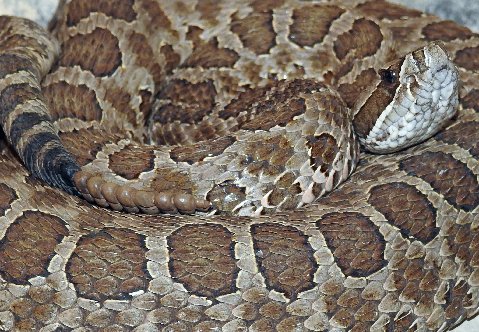
Coiled and posed, a western massasauga on the defensive.
Although the various massasaugas, be they eastern, western, or desert, that I have encountered have moved away at reasonable speed, none, until my recent meeting with western massasaugas, Sistrurus catenatus tergeminus, in Kansas, had I thought of as “speedy.” But those Kansas examples have definitely altered my (and Jake’s) impression of this taxon. The reactions of these snakes, even when approached slowly and carefully, was a headlong dart from the coiled basking position in the grassy center of the road to the safety of the edging rocks. Seemingly with the alacrity usually associated with a basking racer, the crotalines were, if not out of mind, at least out of sight. But we finally managed to find one that, more relaxed than the others, allowed us the hoped for photo ops.
Continue reading "Western Massasauga"
Tuesday, January 30 2018
The best part about corn snakes is their wide variety of looks, like this Striped Sunglow Motley in our herp photo of the day, uploaded by kingsnake.com user jcherry! Be sure to tell them you like it here!

Upload your own reptile and amphibian photos photos at gallery.kingsnake.com, and you could see them featured here!
Monday, January 29 2018
This Diamond Python in our Herp Photo of the day, uploaded by kingsnake.com user CincyGrady really can be a girl's best friend! Be sure to tell them you liked it here!

Upload your own reptile and amphibian photos at gallery.kingsnake.com, and you could see them featured here!
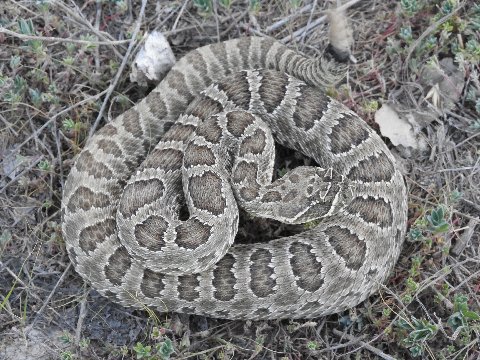
This prairie rattler was one of 3 found on our final day
Central Kansas. Our targets were twofold—a western hognose, Heterodon n. nasicus, and a prairie rattler, Crotalus v. viridis.The afternoon sun shone from a cloudless sky with a palpable force. Despite being basically white in color the roadway we were on was uncomfortably hot. If herps were to be seen at all it would be fleetingly and probably at roadedge. A few minutes before sunset Jake spied the first, a juvenile speckled king snake, Lampropeltis getula holbrooki, that had just emerged from the roadside grasses. This sighting was followed by several western slender glass lizards, Ophisaurus a. attenuata.
One hour passed, then 2. No hoggies, and except for one DOR, no rattlers. And except at the end when we found a very defensive bullsnake, Pituophis catenifer sayi, the next evening was even slower—a couple of pheasants, a lot of slender glass lizards, and incessant lightning accompanying distant storms.
But the third night was the charm. The baking hot day hadn’t seemed much different to me, but the snakes—at least the prairie rattlers, Crotalus v. viridis, found it more favorable. We found the first, a 28 incher, crossing a gravel roadway about a half an hour before sunset. We each took a dozen or more photos and put the snake off of the road. Then came a dozen glass lizards. And then another prairie rattler, this one slightly longer and of a darker color than the first. More pix. It was now nearly dark and for the next hour we saw only crossing glass lizards. Then another rattler. This one, larger still and very dark in color, was photographed in the car’s headlights with the assist of the camera’s flashes, and left as found.
When we left for the southland the next day, we left happy.
Continue reading " Prairie Rattlesnake"
Friday, January 26 2018
Happy Rattlesnake Friday! The icionic Eastern Diamondback just chilling in the sand for our photo of the day uploaded by kingsnake.com user evil-elvis ! Be sure to tell them you liked it here! As always on Friday, we celebrate all of our venomous reptiles for their contribution to the world. It is our goal to help dispel the fears surrounding our beloved venomous creatures.

Upload your own reptile and amphibian photos at gallery.kingsnake.com, and you could see them featured here!
Thursday, January 25 2018
What a great field shot of this Black Salamander found in a redwood forest in our Herp Photo of the day, uploaded by kingsnake.com user sc_shark! Be sure to tell them you liked it here!

Upload your own reptile and amphibian photos at gallery.kingsnake.com, and you could see them featured here!
Wednesday, January 24 2018
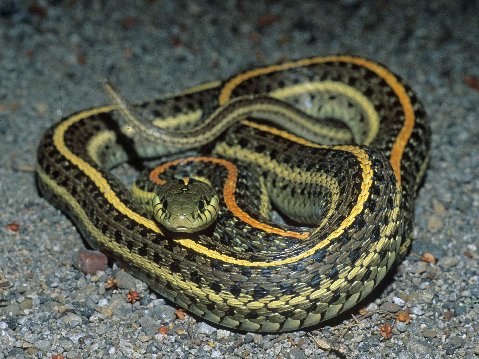
Western Plains garter snakes are pretty and brightly colored.
When it seemed to us that the sun was so hot that it was baking those Kansas dikes, when all good rattlesnakes and Plains leopard frogs were concealed in the roadside grasses, when we had turned the car’s a/c to its lowest temperature, it was then that the Plains garter snakes, Thamnophis radix haydeni, emerged from shelter to bask on the gravel surface. They didn’t stay long, but bask for a few minutes they did before returning to the grasses, presumably to seek their leopard frog or toad repast. While in some areas the Plains garter snake may be difficult to differentiate from congenerics, on these dikes, with the red-sided garter snake being the only other thamnophine contender, there was no problem separating the two. The strong yellow vertebral stripe, placement of the lateral stripe (scale rows 3 and 4), and black spotting (lips and body) of the Plains garter were definitive. Most seen (20+) were juveniles but a half dozen adults were found.
Continue reading "Western Plains Garter Snake"
What a stunning shot of a Painted Mantella ( Mantella baroni) in our herp photo of the day uploaded by kingsnake.com user Hoosierfrogger to brighten your midweek! Be sure to tell them you liked it here!

Upload your own reptile and amphibian photos at gallery.kingsnake.com, and you could see them featured here!
Tuesday, January 23 2018
These adorable Crested Geckos are just hanging around in our herp photo of the day uploaded by kingsnake.com user MOC_Reptiles ! Be sure to tell them you liked it here!

Upload your own reptile and amphibian photos at gallery.kingsnake.com, and you could see them featured here!
Monday, January 22 2018
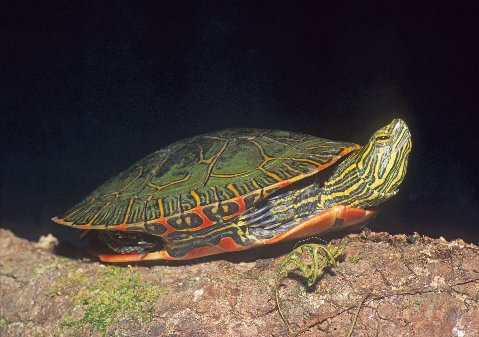
The western painted turtle has carapacial reticulations and a red plastron that bears a complex dark figure.
So pretty are painted turtles, collectively, that were they rare they would command formidably high pet trade prices. However not only are all 4 of the subspecies common, but they breed easily in captivity as well.
In many areas of their extensive ranges the characteristics (carapacial scute sutures and plastral figure) that differentiate the eastern from the midland subspecies ( Chrysemys picta picta and C. p. marginata, respectively) are muddled. But the western form, C. p. bellii, is usually very easily identified and the southern painted turtle, C. p. dorsalis, is so different that it is thought by some to be a full species, designated as C. dorsalis. Although strongly aquatic, painted turtles inhabit semipermanent and permanent ponds, lakes, marshlands, and slow moving riverine sites where they bask on fallen trees and other such haul-out areas. They may also be seen basking well up on shorelines, crossing roadways, and elsewhere as they seek to change their aquatic homes.
Continue reading "Painted Turtles, East, Central, West and South"
Hope your Monday shines like this Northern Pine does in our Herp Photo of the day, uploaded by kingsnake.com user Turekj ! Be sure to tell them you liked it here!

Upload your own reptile and amphibian photos photos at gallery.kingsnake.com, and you could see them featured here!
Friday, January 19 2018
In celebration of all things venomous, ciccada is on the menu for this Copperhead in our herp photo of the day uploaded by kingsnake.com user coolhl7 ! Be sure to tell them you liked it here!

Upload your own reptile and amphibian photos photos at gallery.kingsnake.com, and you could see them featured here!
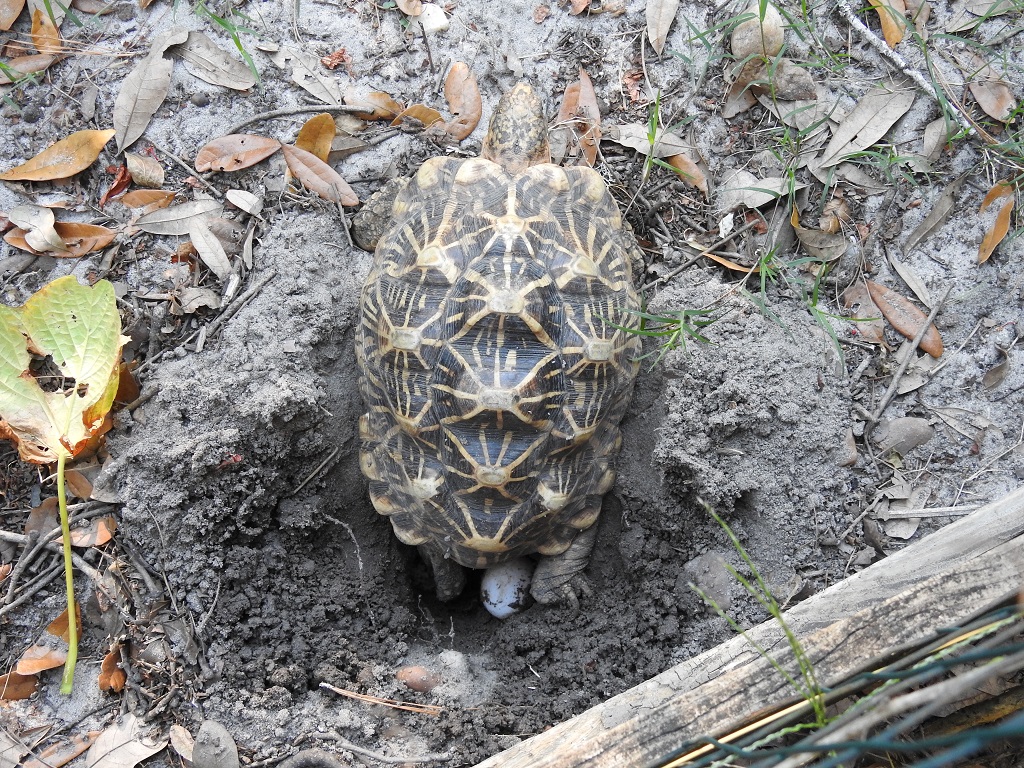
Female Indian star tortoise nesting
Indian star tortoises, Geochelone elegans. The adults, as hatchlings themselves bred at the Knoxville Zoo, were forwarded to Jim Harding by Bern Tryon about 20 years ago. Jim kept them for about 14 years and then deciding the (by then) adults needed some southern sunshine, he brought them to me. These tortoises have proven much more resilient to ambient atmospheric conditions than we initially thought them capable of. They are most active crepuscularly, feeding most ravenously at dusk or even after dark. The females usually begin nesting in the late afternoon, often not completing the task until well after dark. They are usually very active during summer rains, often sitting in the newly formed puddles (that may be 4 or 5 inches deep) from the beginning of the storms until the puddles have fully soaked in. In other words, in their actions and hardiness, these tortoises have been a surprise to me and to Jim. And if Bern were still with us I feel he, too, would have had to modify his beliefs on the captive care required by these beautiful star tortoises.
Fast forward:One female has nested successfully for the last 3 years. In 2017 she nested on 3 occasions at 30 day intervals. Total eggs numbered 14. In Jan of 2015 the first clutch (5 eggs) have hatched and, again at 30 day intervals, we hope that the remaining eggs will also hatch. I’ll keep you updated.
Continue reading "Indian Star Tortoises"
Thursday, January 18 2018
Alert and always keeping his eye on you, this Basiliscus plumifrons shines in our herp photo of the day, uploaded by kingsnake.com user kus! Be sure to tell them you liked it here!

Upload your own reptile and amphibian photos photos at gallery.kingsnake.com, and you could see them featured here!
Wednesday, January 17 2018

Eastern fox Snake waiting for a warbler meal on a cool morning.
From a distance we could see that 9 feet above the ground in a sapling there was a brown ball. Why? What was it? We were on a noted wildlife sanctuary. We neared the “ball” and…Uh oh! Trouble! Not for us but for the warblers that seemed to be using this sapling-top corridor. For just one branch over on this cool morning, coiled tightly around the waving upright trunk, was a beautiful eastern fox snake, Pantherophis vulpinus,(formerly Elaphe vulpina gloydi). We photographed the coiled snake and moved onward, leaving the migrating warblers to fend for themselves. This snake proved to be the first of many, the others being seen along the many dikes. The range of this this pretty northern rat snake closely follows the shorelines of western and northern Lake Erie, eastern Lake Huron, and the region between these two Great Lakes.
Continue reading "Eastern fox Snakes"
Happy Wednesday from this gorgeous pair of Blue Tree Monitors in our herp photo of the day, uploaded by kingsnake.com user roadspawn ! Be sure to tell them you liked it here!
-med.jpg)
Upload your own reptile and amphibian photos at gallery.kingsnake.com, and you could see them featured here!
Tuesday, January 16 2018
It is hard to not see beauty when you look at the Asian Vine Snake ( Ahaetulla prasina) our Herp Photo of the Day, uploaded by kingsnake.com user 13lackcat! Be sure to tell them you liked it here!
 Upload your own reptile and amphibian photos at gallery.kingsnake.com, and you could see them featured here!
Upload your own reptile and amphibian photos at gallery.kingsnake.com, and you could see them featured here!
Monday, January 15 2018
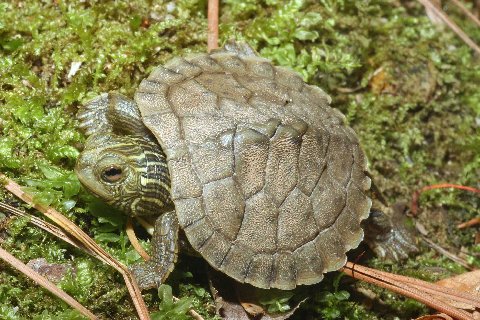
The aberrant carapacial scalation of this wild hatchling common map turtle was probably caused by overly warm incubation temperatures.
Common map turtles, Graptemys geographica. First we saw one. A few moments later it was joined by 2 others, and 5 minutes later there were at least a dozen of these pretty turtles on the large snag we were watching from the car. Knowing how “skittery” this (and other map turtle species) can be, we sat quietly in the car. But there came a moment when we had to position the cameras and as we extended the telephoto lenses from the window of the car, as one the turtles scrambled, dove, and disappeared. Well, we’d try again later, next time from a greater distance.
And so we did. Two times more, in fact, before succeeding. But seeing the many turtles alive, well, and very alert was worth our efforts.
At 10. ½ inches, big-headed adult females of G. geographica, are about twice the size of the 5 inch males. In the western Ohio canal we were now checking, the females seemed to greatly outnumber the males. Here, as in other silted waters, the carapacial pattern tends to be muted by accumulations of water-borne debris. Population and parasite research of the map turtles on the preserve continues.
Continue reading "Common Map Turtles"
Often called the rubber eel, this Rio Cauca caecilian ( Typhlonectes natans) looks quite content in our herp photo of the day, uploaded by kingsnake.com user chrish!
Be sure to tell them you liked it here!

Upload your own reptile and amphibian photos photos at gallery.kingsnake.com, and you could see them featured here!
Friday, January 12 2018
This Cobra in our herp photo of the day, uploaded by kingsnake.com user MaxPeterson just learned we celebrate venomous animals every Friday! Boy is he happy for the respect! As always on Friday, we celebrate all of our venomous reptiles for their contribution to the world. It is our goal to help dispel the fears surrounding our beloved venomous creatures. Be sure to tell him you like it here.

Upload your own reptile and amphibian photos photos at gallery.kingsnake.com, and you could see them featured here!
Thursday, January 11 2018
This boa is chilling out for photo in our herp photo of the day, uploaded by kingsnake.com user pythonas! Be sure to tell them you liked it here

Upload your own reptile and amphibian photos photos at gallery.kingsnake.com, and you could see them featured here!
Wednesday, January 10 2018
Stunning is the only word to describe this Oregon red spotted garter snake in our herp photo of the day, uploaded by kingsnake.com user Concinnitor! Be sure to tell them you liked it here!
-med.jpg)
Upload your own reptile and amphibian photos photos at gallery.kingsnake.com, and you could see them featured here!
Tuesday, January 9 2018
ADORABLE! There is no other way to describe the squee of cuteness that this hatchling Peach Throat Monitor has in our herp photo of the day uploaded by kingsnake.com user MikesMonitors ! Be sure to tell them you liked it here!

Upload your own reptile and amphibian photos photos at gallery.kingsnake.com, and you could see them featured here!
Monday, January 8 2018
Hang in there, just like the Tree Frog in our Herp Photo of the day, uploaded by kingsnake.com user gerrygi! Be sure to tell them you liked it here!

Upload your own reptile and amphibian photos at gallery.kingsnake.com, and you could see them featured here!
Friday, January 5 2018
Happy Rattlesnake Friday! Yeah we know, this Copperhead in our Herp Photo of the Day, uploaded by kingsnake.com user HerpLvr, isn't a rattlesnake! Remember, we salute all our venomous lovelies on Fridays to help raise awareness of their need for greater conservation efforts for their benefit to the entire human race! Be sure to tell them you liked it here!

Upload your own reptile and amphibian photos photos at gallery.kingsnake.com, and you could see them featured here!
Thursday, January 4 2018
The often-underestimated beauty of a Macklot's python shines through in our herp photo of the day, uploaded by kingsnake.com user Bob Garby! Be sure to tell them you liked it here!

Upload your own reptile and amphibian photos photos at gallery.kingsnake.com, and you could see them featured here!
Wednesday, January 3 2018
From his toothy grin, even this Nile Crocodile knows today is a good day in our herp photo of the day, uploaded by kingsnake.com user CDieter ! Be sure to tell them you liked it here!

Upload your own reptile and amphibian photos photos at gallery.kingsnake.com, and you could see them featured here!
Tuesday, January 2 2018
A wonderful field find in Mexico of this Lyre Snake brightens the start of 2018 in our herp photo of the day uploaded by kingsnake.com user Chuck_Ch ! Be sure to tell them you liked it here!

Upload your own reptile and amphibian photos photos at gallery.kingsnake.com, and you could see them featured here!
|


